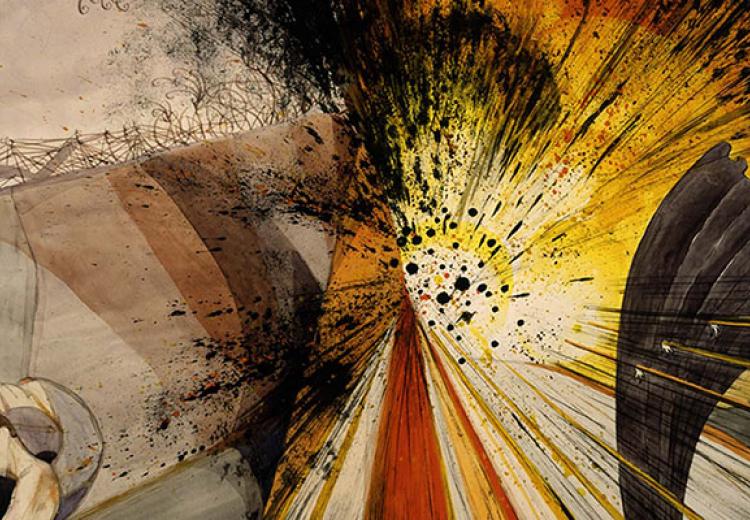World War I and American Art: Part Two

“Flower of Death” (1919). Claggett Wilson
Last time, I began to survey how American artists viewed the Great War (1914–1918). This NEH-supported exhibition, World War I and American Art, has uncovered forgotten works that could help teachers illustrate and illuminate the course of the war, the political opinions pro and con, and the enormous human toll it had on the nation and the world. This week, I’ll talk about some neglected artists who deserve to be remembered as powerful and passionate witnesses to the carnage both on the battlefields and in the hospitals afterward.
But first, let’s begin with a large five-foot-long painting, Gifford Beal’s On the Hudson at Newburgh (1918) that dramatizes the pathos of “leave-taking”—the separation of wives and children from their enlisted husbands and fathers as American troops prepared to relieve the spent allies.
This glorious impressionist landscape depicts an attractive young woman with an infant in her arms and a little girl by her side who watch a distant parade of soldiers marching beneath a pageant of flags toward a waiting locomotive, steam billowing into the early-morning sky. The scene is set in Newburgh, the small town on the Hudson River about sixty miles from New York City, where the artist’s family made their home. The Phillips Collection website points out that the picture celebrates a “sentimental” portrayal of an “idealized American family’s personal sacrifice,” but goes on to add that this kind of sacrifice was repeated in small towns and big cities across the land.
There is fascinating backstory about this canvas that makes it worth considering for a classroom discussion. In 1999, the conservators at the Phillips discovered this picture underneath another Beal painting from 1924, Parade of the Elephants. The curators speculate that the artist, unable to sell the large historical canvas, reused it for one of his more popular circus paintings. Elephants was quickly purchased by Duncan Phillips for his collection. What this suggests to me is that by the 1920s, collectors were no longer interested in acquiring large paintings commemorating the war.
While few American artists witnessed combat firsthand, those who did left striking accounts. Foremost among these was Claggett Wilson, a professionally trained artist who served as a Marine lieutenant. Shortly after the Armistice, Wilson, who was wounded by poison gas in the Battle of Belleau Wood, began a series of harrowing watercolors. In Runner Through the Barrage, Bois de Belleau, Chateau Thierry Sector; His Arm Shot Away, His Mind Gone (ca. 1919), he depicts a young American solider standing in the midst of a forest. All around him, trunks and limbs have fallen. The solider has lost a limb of his own. The title identifies him as a runner, but this runner does not run. He has stopped in his tracks.
The exhibition poster features Wilson’s Flower of Death (ca. 1919). This near-abstract watercolor depicts the impact of an explosion on the surrounding landscape. And as its subtitle (The Bursting of a Heavy Shell—Not as it Looks, but as it Feels and Sounds and Smells) makes clear, the image throbs with violent energy. War, as generations of artists and filmmakers have known, can be visually beautiful or awe-inspiring. Wilson conveys the repulsion and attraction of the battlefield in the first age of technological warfare.
Horace Pippin, a member of the Harlem Hellfighters, suffered combat injuries that damaged his right arm, and he first began making art as a means of physical rehabilitation. A handmade memoir filled with sketches details his wartime experience from deployment to demobilization. In the 1930s he would return to this pivotal moment in his life with The Barracks to express both traumatic and mundane aspects of military service. Younger students (grades K-5) can learn more about this important artist and his work with the lesson plan on the National Gallery of Art website.
Romaine Brooks’s heroic portrait of the nurse in a windswept landscape near Ypres, The French Cross, is one of the most important works by this pioneering feminist artist and an example of how an anti-war artist helped support relief efforts. Many of her paintings and drawings were donated to the Smithsonian American Art Museum, where one can learn more about this painting and her art. Claggett Wilson’s Underground Dressing Station also honors the self-sacrificing dedication that nurses, doctors, and recovery crews brought to the field.
John Singer Sargent’s stupendous canvas, Gassed (1919), functions as a kind of “Big Bertha” in this exhibition. The frieze-like image derives from a scene the artist witnessed and that haunted him: rows of British soldiers temporarily blinded by mustard gas, with their heads wrapped in gauze to protect their eyes, being led by orderlies at an evacuation checkpoint, to a dressing station.
The renowned painter had grown weary of producing the society portraits that had made his reputation. Viewed as old fashioned and over the hill by younger artists, he was determined to make this commission from the British government into a lesson for posterity. Ironically echoing Pieter Bruegel’s The Blind Leading the Blind, the 20-foot-by-8-foot canvas teaches what can be achieved, when commenting, in this case, on the enormous waste and tragedy of war, by looking closely at the “Old Masters.” As W. H. Auden put it in the first line of his famous poem “Musée des Beaux Arts,” “About suffering they [the Old Masters] were never wrong.”
With the exception of Gassed, the works by Spear, Sloan, Bellows, Wilson, Pippin, and Brooks mentioned in these blog posts are drawn from Washington-area collections (National Gallery, Phillips Collection, Library of Congress, and the Smithsonian Museum of American Art) and are fully accessible online.
